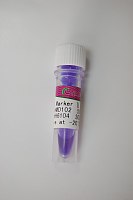Transfection of E. coli with M13 DNA
互联网
571
In recent years several techniques have been described for the introduction of DNA molecules into strains of E. coli by transformation or transfection. These are based on the findings of Mandel and Higa (1 ) who demonstrated that incubation of cells with naked bacteriophage λ DNA in cold calcium chloride resulted in uptake of virus and that a transient heat-shock of the mixture greatly enhanced the efficiency of transfection. Subsequently, this method was used to introduce a variety of circular and linear DNAs into strains of E. coli , and many variations in the technique have been described that are aimed at increasing the yield of transformants or transfectants. The central requirements for success are the presence of multivalent cations, an incubation temperature close to 0°C, and a carefully controlled heatshock at 42°C, but a number of other compounds and procedures have been found to increase efficiency in some or all strains of E. coli that have been tested. The mechanisms involved in DNA transformation of cells are not fully understood and even with the most efficient methods that are available the proportion of cells that become “competent” for transformation is limited to around 10% of the total population.







